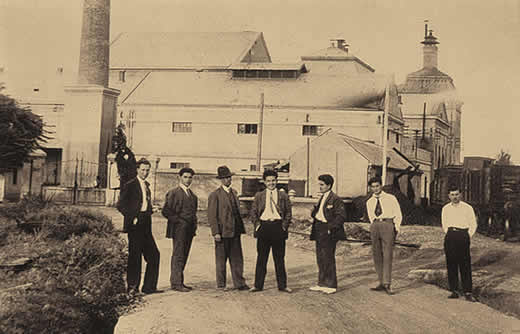
1922–41

In the aftermath of the First World War and especially in the first post-war years, foreign capital started finding its way to the Balkan, while the most common form thereof was establishment of Joint Stock Companies with dominant foreign equity.
September 2, 1922 ― A shareholders’ assembly of the joint-stock company “Parna Pivara AD” was held, which established the first brewery in this area.
Skopje’s Steam Brewery was established mostly due to the fact that there were no breweries south of Jagodina. In the same period, the Brewery in Nis was opened, but smaller in size and capacity compared to the one in Skopje.
On a land of 32,347 m2 area, in the vicinity of the railway line Skopje–Nis, two kilometres east of Skopje and marked the start of the factory’s construction. The Steam Brewery in Skopje was established the same year and registered as industrial enterprise. It was founded by two Czechs: engineer Victor Zeiss and banker Karel Husnik. They invested three million dinars, and doubled the investment one year later, while in 1924 it amounted to nine million dinars.
1924 – The brewery was put into operation and the first glass of beer is drank according to an old Czech recipe, with a special taste obtained by the local well water of Skopje, the beer which later will be recognized by a generation after generation simply as – SKOPSKO.
In the pre-war period, the Brewery’s annual production capacity was 35,000 hectolitres beer, 720 tons beer malt and 1,500 tons ice.
1925 – “Parna Pivara AD” obtained a permission to supply the entire southern region of the then state, after which the company will soon open its warehouses and ice houses in Kumanovo, Prilep, Bitola, Strumica and Kosovo Mitrovica.
Trivia:
Until 1941, administrative and production facilities of the Brewery were accommodated on an area of 5,919 m2. They included: factory building, malt unit, milling unit, brewing units, cooling unit, fermentation unit, storage unit, beer filtration, bottling and pasteurization unit together with amenities for barrel soaking, cleaning and paraffin-coating, amenities for filling barrels, as well ice-production unit and machinery and technology maintenance unit.
Before the war’s onset, working days consisted of 8 hours. Given that beer was most consumed in summer, in the period from 1 April until 30 September the Brewery operated seven days a week. In autumn and winter, it operated only three days a week. In the last three years prior to the war, beer production and consumption increased in proportion and required the Brewery to operate in full capacity throughout the entire year.









